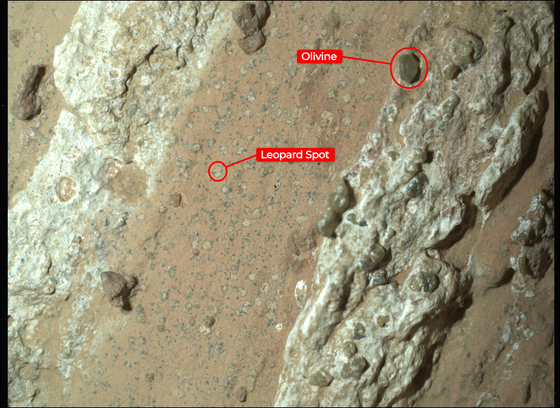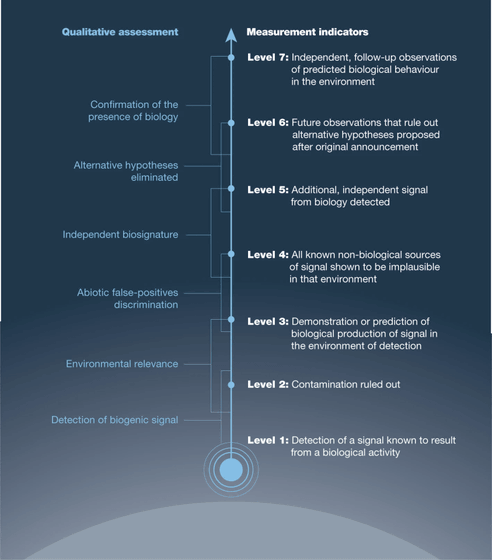NASA announces discovery of 'evidence that suggests life on Mars is highly likely'

NASA announced that it has determined that minerals discovered by the Mars rover
NASA Says Mars Rover Discovered Potential Biosignature Last Year - NASA
https://www.nasa.gov/news-release/nasa-says-mars-rover-discovered-potential-biosignature-last-year/
Redox-driven mineral and organic associations in Jezero Crater, Mars | Nature
https://www.nature.com/articles/s41586-025-09413-0
Researchers uncover potential biosignatures on Mars – Texas A&M Stories
https://stories.tamu.edu/news/2025/09/10/researchers-uncover-potential-biosignatures-on-mars/
You can learn more about the minerals discovered by Perseverance in 2024 by reading the article below.
NASA's Mars rover Perseverance discovers rocks suggesting 'signs of life' - GIGAZINE

'The new findings in this paper are the discovery of specific mineral aggregates that are thought to have been produced by redox reactions within mudstone containing organic carbon. Perseverance conducted its research in a geological formation known as the Bright Angel in the Neretva Valley on the western edge of the Jezero Crater . Here, the onboard analytical instruments discovered mudstone rich in iron, phosphorus, and sulfur.
Of particular importance are two distinctive structures found in the mudstone. One is 'poppy seeds,' which are nodules less than 1 mm in diameter, and the other is 'leopard spots,' which are reaction surfaces several mm in diameter. Detailed analysis revealed that these are rich in the minerals ferric phosphate and iron sulfide.

On Earth, many microorganisms are known to use iron oxide (rust) or sulfate instead of oxygen to obtain energy. Iron-using microorganisms may produce ferric phosphate as a by-product, while sulfate-respiring microorganisms may produce iron sulfide as a by-product.
The minerals discovered this time were found in mudstone rich in organic carbon, phosphorus, and sulfur, which could serve as an ideal energy source for microorganisms. Furthermore, the distribution and shape of the minerals suggest that they were produced in situ through chemical reactions using surrounding organic matter, which is consistent with the metabolic activity that microorganisms use to obtain energy.
What's more, the environment in which these reactions occurred strongly supports the hypothesis of traces of life. Analysis of the rocks revealed that the area where the minerals were discovered showed no signs of high temperature exposure. If the reaction to produce iron sulfide were an abiotic process, it would require high temperatures of 150 to 200 degrees Celsius. NASA states that it is difficult to explain the formation of these minerals in such a low-temperature environment with only abiotic processes.
'Astrobiological claims, particularly those related to the potential discovery of past extraterrestrial life, require extraordinary evidence,' said Katie Stack Morgan, a researcher at NASA's Jet Propulsion Laboratory (JPL). 'Publishing such an important discovery of potential life indicators on Mars in a peer-reviewed paper is a crucial step in the scientific process, as it ensures the rigor, validity, and importance of our results.'
The newly discovered mineral qualifies as close to Level 4 on the Confidence in Life Detection (CoLD) scale, which assesses scientific confidence that 'all known non-biological causes of a signal in that environment have been shown to be implausible.' However, non-biological causes have not been completely ruled out, so future research aims to solidify the confidence level at Level 4 on the CoLD scale.

'Given our findings, while the absence of abiotic intervention in the events observed at Bright Angel is unlikely, we cannot rule it out,' said Morgan. Michael Tice, a geologist at Texas A&M University and co-author of the paper, added, 'To fully rule out the possibility that the minerals discovered here could have been formed non-biologically, we need experiments on Earth and ultimately laboratory samples.'
Perseverance has already collected a core sample named 'Sapphire Canyon' from a rock called 'Cheyava Falls' in the Bright Angel Formation. It is expected that this sample will be brought back to Earth on a future mission and analyzed with more sophisticated equipment, which will allow for a final conclusion as to whether it is a trace of life.
Related Posts:
in Science, Posted by log1i_yk






